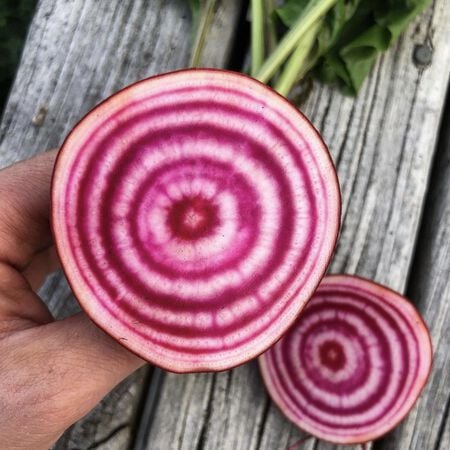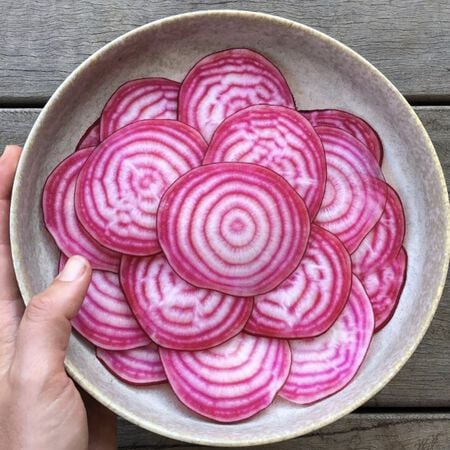Chioggia, Beet Seeds
Key Attributes
Chioggia beets, also known as Candy Cane or Bull's Eye beets, are a unique and visually striking variety of beets that originated in Italy. Their history dates back to the early 19th century when they were first cultivated in the coastal town of Chioggia, near Venice. These beets are renowned for their vibrant and eye-catching appearance, characterized by concentric rings of alternating red and white colors, reminiscent of a candy cane. This distinct coloration makes them a popular choice among gardeners and chefs for their ornamental and culinary appeal.
In terms of taste, Chioggia beets offer a mild and slightly sweet flavor, making them a versatile ingredient in various dishes. They can be enjoyed raw in salads, pickled, roasted, or boiled, and their taste becomes sweeter when cooked. Typically, Chioggia beets are round to slightly flattened in shape, with a diameter of 2 to 3 inches. They are known for their relatively quick maturity, taking around 50 to 60 days to reach full size. Their unique coloration is retained even after cooking, making them a visually stunning addition to any meal.
When it comes to growing Chioggia beets, they thrive in well-drained soil with a neutral pH and require full sun for optimal growth. Proper spacing is essential to allow room for their roots to develop, typically requiring 3 to 4 inches between each plant and rows spaced about 12 to 18 inches apart. Chioggia beets are relatively disease-resistant, with a natural ability to withstand some common beet diseases, but it's still essential to monitor them for any signs of issues. With proper care, Chioggia beets can yield a bountiful crop, and their unique appearance and delightful taste make them a favorite among gardeners and culinary enthusiasts alike.
Product Details
Weight
0.018Depth
0.3Height
4.5Width
3.25Plant Height
10-14"Botanical Name
Beta vulgarisSeed Type
SeedSeeds Per Gram
77Seeds Per Pound
35,000Row Spacing
24"Packet
200 SeedsSow Depth
1/2"Beet Shape
RoundSeeds Per Ounce
2,188Fruit Color
Red,WhiteBreed
Open-pollinatedSun
Full SunMaturity
Main SeasonLife Cycle
AnnualSow Method
TransplantPlant Spacing
2-4"Categories
BeetGermination
5,6,7,8,9,10Days To Maturity (# Days)
55Seeds Per Acre
13 lbsComponents
Growing Instructions
![]() Learning Download: How to Grow Beets
Learning Download: How to Grow Beets
Beets are a unique root vegetable edible for both its bulb and green tops. The vegetable is a biennial, which means they flower and seed in their second year of growth, but beets are typically grown as an annual.
Before Planting: Beets grow quickly in light or loamy soils with a pH over 6.0. In general, cool temperatures produce the best flesh color. Weather temperature fluctuations will cause white rings in the roots.
Planting: Begin sowings when soil has warmed to 45°F. Sow 12-15 seeds/ft. 1/2″ deep, rows 14-18″ apart. Thin to 1 plant per 2″ when true leaves begin to show. For a continuous supply of greens and small tender beets, sow seed at 2-week intervals until 8 weeks before regular heavy frosts are expected. Sow seeds 4-6 weeks before transplanting out after heavy frosts have decreased. Sow seeds 1/2″ deep, 2-3 seeds per cell. Transplant out 3″ apart in rows 14-18″ apart.
Watering: Since beets consist of mostly water, the plant requires adequate watering to grow. Water beets at least an inch weekly if rain doesn’t supply enough moisture. Water slowly to permeate the soil and reach the root.
Fertilizer: Apply some high-nitrogen fertilizer six weeks after planting.
Days to Maturity: 14-21 days to have transplant ready, then see days to maturity for each variety.
Harvesting: Sow about 10 weeks before heavy freeze is expected. Dig under beet root and lift plants tops, wash, and store 6 months at 32°F and high humidity. Wash and put in cool location. Store cool and high humidity for best results.
Tips: Though beets can grow in partial shade, their roots may run into tree roots, so plant in deep soil.
AVG. Seeding Rate: 1M/66′, 5M/333′, 436M/acre @15 seeds/ft. and 18″ between rows.
Shipping Schedule
Our Seed Promise
 "Agriculture and seeds" provide the basis upon which our lives depend. We must protect this foundation as a safe and genetically stable source for future generations. For the benefit of all farmers, gardeners and consumers who want an alternative, we pledge that we do not knowingly buy or sell genetically engineered seeds or plants.
"Agriculture and seeds" provide the basis upon which our lives depend. We must protect this foundation as a safe and genetically stable source for future generations. For the benefit of all farmers, gardeners and consumers who want an alternative, we pledge that we do not knowingly buy or sell genetically engineered seeds or plants.
The mechanical transfer of genetic material outside of natural reproductive methods and between genera, families or kingdoms, poses great biological risks as well as economic, political, and cultural threats. We feel that genetically engineered varieties have been insufficiently tested prior to public release. More research and testing is necessary to further assess the potential risks of genetically engineered seeds. Further, we wish to support agricultural progress that leads to healthier soils, to genetically diverse agricultural ecosystems, and ultimately to healthy people and communities.
To learn more about the "Safe Seed Pledge" please visit www.councilforresponsiblegenetics.org.
Key Attributes
Product Details
Weight
0.018Depth
0.3Height
4.5Width
3.25Plant Height
10-14"Botanical Name
Beta vulgarisSeed Type
SeedSeeds Per Gram
77Seeds Per Pound
35,000Row Spacing
24"Packet
200 SeedsSow Depth
1/2"Beet Shape
RoundSeeds Per Ounce
2,188Fruit Color
Red,WhiteBreed
Open-pollinatedSun
Full SunMaturity
Main SeasonLife Cycle
AnnualSow Method
TransplantPlant Spacing
2-4"Categories
BeetGermination
5,6,7,8,9,10Days To Maturity (# Days)
55Seeds Per Acre
13 lbsComponents
Growing Instructions
![]() Learning Download: How to Grow Beets
Learning Download: How to Grow Beets
Beets are a unique root vegetable edible for both its bulb and green tops. The vegetable is a biennial, which means they flower and seed in their second year of growth, but beets are typically grown as an annual.
Before Planting: Beets grow quickly in light or loamy soils with a pH over 6.0. In general, cool temperatures produce the best flesh color. Weather temperature fluctuations will cause white rings in the roots.
Planting: Begin sowings when soil has warmed to 45°F. Sow 12-15 seeds/ft. 1/2″ deep, rows 14-18″ apart. Thin to 1 plant per 2″ when true leaves begin to show. For a continuous supply of greens and small tender beets, sow seed at 2-week intervals until 8 weeks before regular heavy frosts are expected. Sow seeds 4-6 weeks before transplanting out after heavy frosts have decreased. Sow seeds 1/2″ deep, 2-3 seeds per cell. Transplant out 3″ apart in rows 14-18″ apart.
Watering: Since beets consist of mostly water, the plant requires adequate watering to grow. Water beets at least an inch weekly if rain doesn’t supply enough moisture. Water slowly to permeate the soil and reach the root.
Fertilizer: Apply some high-nitrogen fertilizer six weeks after planting.
Days to Maturity: 14-21 days to have transplant ready, then see days to maturity for each variety.
Harvesting: Sow about 10 weeks before heavy freeze is expected. Dig under beet root and lift plants tops, wash, and store 6 months at 32°F and high humidity. Wash and put in cool location. Store cool and high humidity for best results.
Tips: Though beets can grow in partial shade, their roots may run into tree roots, so plant in deep soil.
AVG. Seeding Rate: 1M/66′, 5M/333′, 436M/acre @15 seeds/ft. and 18″ between rows.
Shipping Schedule
Our Seed Promise
 "Agriculture and seeds" provide the basis upon which our lives depend. We must protect this foundation as a safe and genetically stable source for future generations. For the benefit of all farmers, gardeners and consumers who want an alternative, we pledge that we do not knowingly buy or sell genetically engineered seeds or plants.
"Agriculture and seeds" provide the basis upon which our lives depend. We must protect this foundation as a safe and genetically stable source for future generations. For the benefit of all farmers, gardeners and consumers who want an alternative, we pledge that we do not knowingly buy or sell genetically engineered seeds or plants.
The mechanical transfer of genetic material outside of natural reproductive methods and between genera, families or kingdoms, poses great biological risks as well as economic, political, and cultural threats. We feel that genetically engineered varieties have been insufficiently tested prior to public release. More research and testing is necessary to further assess the potential risks of genetically engineered seeds. Further, we wish to support agricultural progress that leads to healthier soils, to genetically diverse agricultural ecosystems, and ultimately to healthy people and communities.
To learn more about the "Safe Seed Pledge" please visit www.councilforresponsiblegenetics.org.




